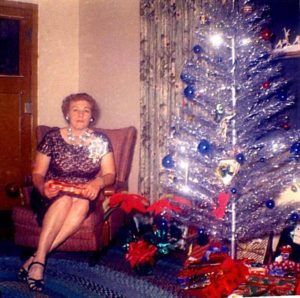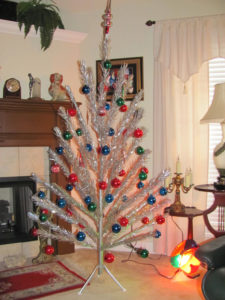
It was great growing up in the Jet Age, which melded seamlessly into the Space Age.
We took the Art Deco dream and turned it into real life. The ultra-modern, automated society that was envisioned by the generation that endured the Great Depression was becoming real for us, the Baby Boomers.
What better way to turn the old into new than to remove that messy firetrap known as the Christmas tree and replace it with a beautiful, shimmering aluminum model, complete with bright blue globes and a light wheel that would magically transform it into a rainbow of colors in a darkened room?
Thus did many of us grow up with memories of, not coniferous smells, strings of lights, or mom sweeping up dead needles on a daily basis, but instead, past visions of conical-shaped metallic tannenbaume that lived in boxes in the attics eleven months per year.
The aluminum Christmas tree can trace its “roots” (groan) to 1958. It all began in Chicago, when an anonymous enterprising Ben Franklin store employee created a small Christmas tree out of metal and put in a window display. Tom Gannon, who worked for Manitowoc, Wisconsin’s Aluminum Specialty Company as the toy sales manager, was in town for a visit, and he was impressed. So when he went back home, he pitched the idea of an aluminum tree to the company president. You see, Manitowoc was known as the Aluminum Cookware Capital of the World. So why not create a Christmas tree out of the same material, which could be used year after year, and which would leave nary a stray needle on the carpet?
The president was impressed, and designers soon set to work. By late 1959, the aluminum Christmas tree was offered for sale to the public.

The tree was in a kit form that would be assembled by the homeowner. The package included a floodlamp with a rotating four-colored disk in front of it that would change the colors of illumination every fifteen seconds or so.
There was a very practical reason for the lamp’s inclusion. The first trees’ branches were made of aluminum-covered paper which was even more flammable than spruce needles. Not only that, but a broken bulb could cause a nasty short circuit amongst the metallic foliage. So customers were strongly discouraged from hanging any other types of lights on the tree. However, bright blue ornaments were encouraged (and included in many packages).
The trees sold fairly well the first year, but the 1960 Christmas season saw their numbers skyrocket. Thus did many of us have sweet memories planted in our young minds of glorious scintillating aluminum branches that magically changed colors before our very eyes.
The boom lasted for ten years. During this time, colored trees appeared with shades like blue, pink, and green (imagine that!). Then, closely paralleling the same fate and timeline of plastic pink flamingos, they fell out of style and began to be considered tacky.
But, like their polycarbonate avian brethren, aluminum trees have once again become fashionable in a retro sense. Thus, at least one brick-and-mortar museum dedicated to aluminum trees, ATOM (site has been shut down), exists, and vintage aluminum trees in immaculate shape sell on eBay for prices approaching four figures.
And yes, they are making them again. The ones our parents bought were less than ten clams. At this site (site has been shut down), (sale) prices range from 289 to 939 bucks.
So, like many of our memories, you can once again enjoy this blast from the past. Just remember to bring a fat pocketbook with you…
My grandmother on my mother’s side had one, the only one that anyone had that I remember. My cousin was allergic to everything as a baby so it eliminated one potential problem. My siblings and I hated it! It was sterile and appealing as a TV antenna, it was sharp and pokey and held more static electricity than three panhandle thunderstorms, and it looked incongruous next to her Jacquard upholstered rococo style furniture. We fled that living room immediately after opening presents.